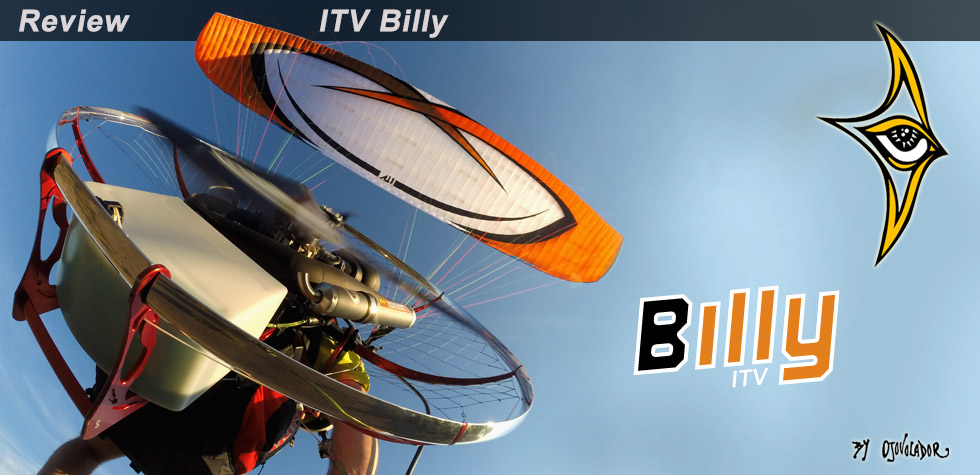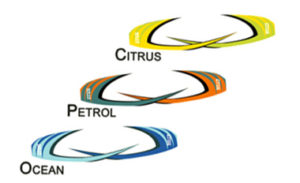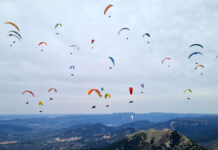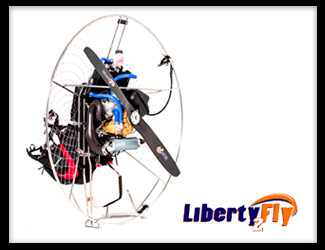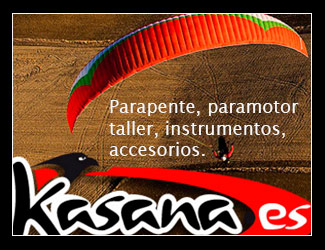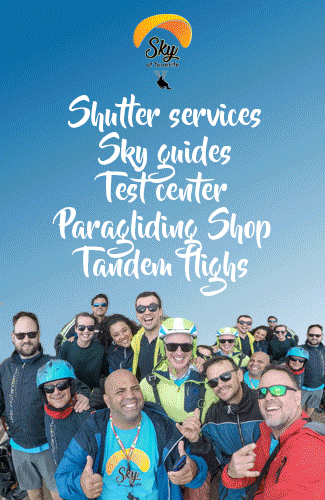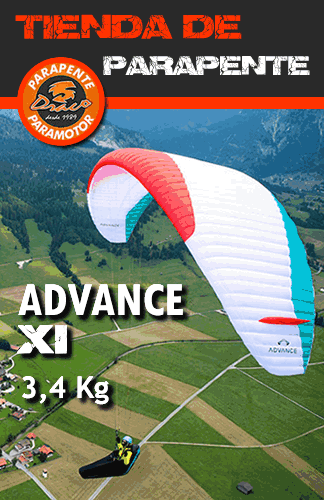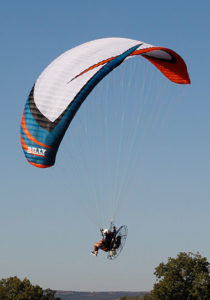 The Billy is the first full-reflex glider from ITV. The French manufacturer has been offering dedicated paramotor wings for many years; in the current range there are gliders from ‘best-sellers’ semi-reflex ones, like the Boxer (entry level) and the Boxer GT (intermediate), to the slalom world champion wing, the Fury.
The Billy is the first full-reflex glider from ITV. The French manufacturer has been offering dedicated paramotor wings for many years; in the current range there are gliders from ‘best-sellers’ semi-reflex ones, like the Boxer (entry level) and the Boxer GT (intermediate), to the slalom world champion wing, the Fury.
The ITV Billy is placed as an intermediate-advanced reflex paraglider aimed at confirmed pilots who want to enjoy great stability and top performance, with sporty handling and lots of speed, but without the technical requirements and vulnerability of more advanced gliders.
The Billy’s handling is dynamic, smooth and easy to understand. The brake travel is in the middle range, progressive and direct.
 Regarding turning behaviour, although it is not a slalom wing it has a surprising sporty character and good touch with dynamic responses and precise traces. The reflex profile offers a remarkable extra solidity: as soon as you enable it the Billy seems to be made of wood and becomes an “air express”, solid and fast to navigate.
Regarding turning behaviour, although it is not a slalom wing it has a surprising sporty character and good touch with dynamic responses and precise traces. The reflex profile offers a remarkable extra solidity: as soon as you enable it the Billy seems to be made of wood and becomes an “air express”, solid and fast to navigate.
The ITV Billy has 58 cells and aspect ratio of 5.38. Top speed is around 65 km/h, and it is available in four sizes and 3 colour schemes with a variation on ITV’s visual design.
Inflation
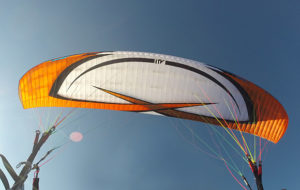 The leading edge of the ITV Billy is perfectly exposed to receive air, it does not require any particular arrangement for starting, but in nil wind conditions a horseshoe array of the glider will help it raise centred. With a little wind everything is very easy and the Billy asks for a short run to take off, but when there is no wind you will have to run as this glider is fast (44-45 km/h trim speed) even if you brake it. This should not pose a setback for the type of pilot –progression to expert– at which it is aimed.
The leading edge of the ITV Billy is perfectly exposed to receive air, it does not require any particular arrangement for starting, but in nil wind conditions a horseshoe array of the glider will help it raise centred. With a little wind everything is very easy and the Billy asks for a short run to take off, but when there is no wind you will have to run as this glider is fast (44-45 km/h trim speed) even if you brake it. This should not pose a setback for the type of pilot –progression to expert– at which it is aimed.
Flying
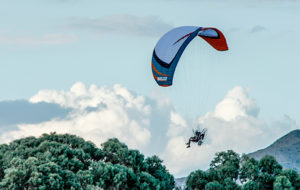 Once in the air, when we let it fly, the Billy picks up speed and lets us feel its consistency.
Once in the air, when we let it fly, the Billy picks up speed and lets us feel its consistency.
Profiles cut in the air cleanly with precise trajectories and balanced turns. With speed we also gain pressure on the brakes and notice direct response to the least corrections.
The trimmer is long and strong. When totally closed, the glider is already fast; this is the 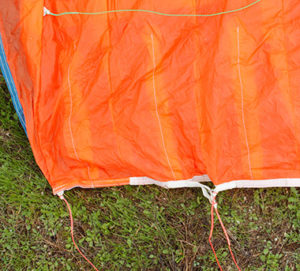 position to take off and stroll around with the best sink rate.
position to take off and stroll around with the best sink rate.
There are two positions marked; with the trimmer in the first we will gain a few km/h, with more reflex and solidity. If we open the trimmer setting ‘full reflex’ mode, the ITV Billy will have extra stability and resistance to turbulence.
On this position we have to steer and make course corrections using the auxiliary brake line that works only on the wingtips.
Dual control and piloting modes
The Billy has a “dual” slalom-type brake system, i.e., the main brake line passes through the pulley and joins a line on the swivel that brakes only the wingtip. This way we can brake the tip, the centre of the glider, or both.
 The system is well resolved and, better, it is effective. You can handle the Billy in the usual way when the trimmer is closed, or navigate with the reflex activated and pushing the speed bar, correcting with the wingtips. Or even do a mixed slalom-type piloting, speeding up in the straight sections and handling with the wingtips to slow down by the pylon and brake the centre of the glider.
The system is well resolved and, better, it is effective. You can handle the Billy in the usual way when the trimmer is closed, or navigate with the reflex activated and pushing the speed bar, correcting with the wingtips. Or even do a mixed slalom-type piloting, speeding up in the straight sections and handling with the wingtips to slow down by the pylon and brake the centre of the glider.
The risers are thin but quite sturdy, with split “As” marked in red. They come with two positions for the brake pulleys, to suit high and low paramotor hang points. The brake handle is large and semi-soft, and incorporates swivels and a flexible bar to control the wingtips.
Navigating
When the time came to cover ground the ITV Billy dazzled us with its great potential.
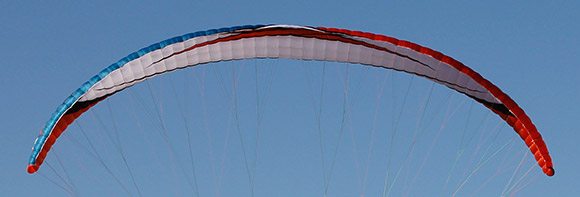 Flying hands up it goes at 44 – 45 Km/h. Then we released the entire trimmer to activate reflex mode and we stepped on the speed bar to the top, a speed system with 2mm braided dynema line, fairly short, soft and effective, that allowed us to reach 63 km/h flying foot launched with 145 kg; a couple of km/h more on paratrike with 165 kg.
Flying hands up it goes at 44 – 45 Km/h. Then we released the entire trimmer to activate reflex mode and we stepped on the speed bar to the top, a speed system with 2mm braided dynema line, fairly short, soft and effective, that allowed us to reach 63 km/h flying foot launched with 145 kg; a couple of km/h more on paratrike with 165 kg.
Directional stability is excellent and just little corrections are needed to keep the course. Only when we go through turbulent areas the Billy might shift direction, in which case we will have to use the wingtip line to keep the course.
Turbulences
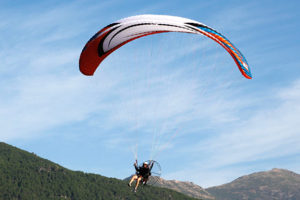 We had the chance to fly the ITV Billy in laminar wind. Any pilot will be able to take it to its maximum speed of 65 Km/h in these conditions, but things change with turbulence. Then, we will have to control it with the wingtip line, keeping in mind that on reflex wings the reflex is deactivated if we brake the centre of the trailing edge, leaving the glider more prone to collapses. The Billy is stable in pitch, but it tends to dissipate the movements of the air with changes of direction which, in strong turbulence, can be important.
We had the chance to fly the ITV Billy in laminar wind. Any pilot will be able to take it to its maximum speed of 65 Km/h in these conditions, but things change with turbulence. Then, we will have to control it with the wingtip line, keeping in mind that on reflex wings the reflex is deactivated if we brake the centre of the trailing edge, leaving the glider more prone to collapses. The Billy is stable in pitch, but it tends to dissipate the movements of the air with changes of direction which, in strong turbulence, can be important.
Turning
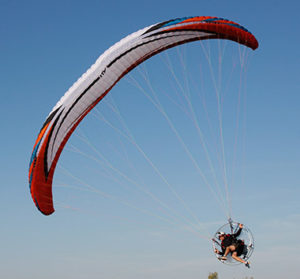
The ITV Billy has a live and energetic turn; it keeps speed reserves and offers a good control of inertia with adequate pressure along the span, including the tips. This translates into precise paths with immediate changes of direction, easy management of speeds, and great control of the surge. The adrenaline dose is guaranteed.
With closed trimmer the Billy turns very well. As we release trimmer we’ll find that the brake will harden as we gain speed, so we will have to find our point. I liked it best with the trimmer open a couple of centimetres. In this setting the wing gains speed and reflex, it remains very manoeuvrable, draws precise traces, keeps the pressure and – above all – it offers a sporty and direct handling.
Flare
The Billy offers an extensive return of height for speed, which is reflected in the turns and also when landing with the engine off: you can let the wing fly at full speed during the final section of the approach and even step on the speed bar to produce a long glide of ground effect; the final round up or flare will be long and you’ll touch the ground smoothly.
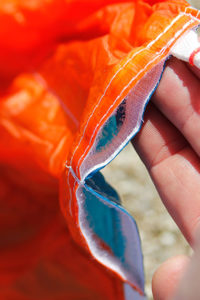 For whom
For whom
The ITV Billy is aimed at confirmed pilots. It is not a complicated wing, but it is fast and agile and, therefore, it calls for sensitive and precise hands. It is a glider for a type of intermediate-advanced pilot who wants to enjoy quality handling and good performance but without getting close to the limits, as it is the case with small and spicy competition gliders. Could a pilot in progression get used to it? Yes, some newbies have good feeling and progress fast and safely but, attention, it is important to choose smooth conditions for the first flights and be cautious at the controls on the first evolutions in sporty handling.
Conclusion
An advanced glider with reflex solidity to navigate at top speeds, the Billy combines speed and performance with light and agile handling. An ideal choice for those looking for a multipurpose sport wing just below dedicated slalom wings.
The+: Versatile sporty wing: fast, stable and at the same time manoeuvrable
The–: Changes of course to absorb turbulence in reflex mode
| Technical data ITV Billy | ||||
| Size | XS | S | M | L |
| Aspect ratio | 5.4 | 5.4 | 5.4 | 5.4 |
| Cells | 58 | 58 | 58 | 58 |
| Weight range paraglider Kg | 65-85 | 80-95 | 90-120 | 110-140 |
| Weight range paramotor Kg | 65-110 | 80-100 | 90-140 | 110-160 |
|
Materials
|
||||
| Outer sail | Dokdo 30D 40 g/m² | |||
| Inner sail | Dokdo 20D 35 g/m² | |||
| Lines | 1.7/1.0 mm Aramid 100/280 | |||
| Certification | Paramotor | |||
| Manufacturer’s suggested price | 3.080€ | |||
+ Info: www.itv-parapentes.com


